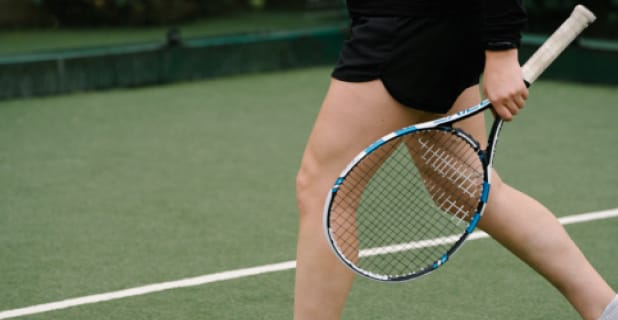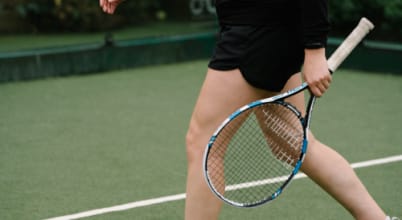Top 3 Tennis Injuries: Prevention and Management

Dr Michael Burdon
Consultant in Sport, Exercise & Musculoskeletal Medicine
- 21 September, 2018
- Tennis
- 3 min read
As when any major Grand Slam tournament is on, people around the world are reminded of their love for tennis.

Whether it is in January with the Australian Open, or summer time with Wimbledon, the public will dust off their racquets, grab their tennis shoes and hire a court. It is this love of tennis that keeps many people playing all year round but with the increase in popularity during the Grand Slams, naturally, the number of tennis related injuries we see increases.
We take a look at three of the most common tennis related injuries, discuss what they mean and how we would diagnose and manage them, so you know what to do if you or your partner experiences one of them. Early diagnosis and the appropriate treatment could be the difference between you staying on the court, or having to take a season out to recover.
1. Shoulder Impingement
The shoulder is a very mobile joint that allows us to move our arm into a variety of positions for optimal function. This is very important in sports such as tennis where such a wide range of motion is needed. However, this can mean that the shoulder is vulnerable to some injuries and one of these is known as shoulder impingement.
Impingement usually happens over time and with repetitive use of the shoulder. Pain may be noticed when playing overhead shots and serving. It can be due to a variety of factors but means that the tendon and bursa in the shoulder may be caught or “impinged” underneath the bone. Players will often complain of sharp pain in the front, and deep in, the shoulder. If it progresses it can start to cause more pain and affect performance on the court.
Our Physiotherapy team are all experienced in the rehabilitation of shoulder injuries and this often complements injections, when necessary, well. Prevention of such injuries is of course very important going forward and our Physiotherapy team can provide this for you.
2. Calf Tears
A tear in the calf muscle is one of the more common injuries that we see at Pure Sports Medicine and is classically associated with Tennis, in fact it is often called “Tennis Leg”.
Usually the inside calf muscle, the medial head of gastrocnemius, is involved. Players often feel a sudden, severe pain especially when planting the foot down whilst playing tennis. Often bruising and swelling happen quickly afterwards. It can be difficult to walk and often crutches are needed to mobilise. Applying ice and a compression bandage is very important to reduce the amount of bleeding.
These injuries are usually classified as grade 1 to 3. Grade 1 represents some mild tearing of the muscle fibres, whereas in grade 2 more extensive damage occurs. In grade 3 a full rupture or complete tear occurs.
Early diagnosis and correct management is really important. Our Sport, Exercise & Musculoskeletal Medicine Consultants or Physiotherapists would assess the injury with clinical testing, including range of movement, strength and function. Again, the use of Diagnostic Ultrasound is very useful to image the injury and determine the type and extent of the injury that has occurred.
Recovery varies from a couple of weeks to several months in some cases, and a robust Physiotherapy / rehabilitation approach usually works very well. Its is important to fully recover before returning to tennis to reduce the risk of a recurrent injury.
3. Tennis Elbow
Tennis elbow is a common condition that affects many people, including those that play tennis. It leads to pain felt on the outside part of the elbow where the wrist extensor muscles attach to the bone of the elbow called the lateral epicondyle.
This can be due to repetitive movements including backhand strokes. Good technique and racquet grip is important to reduce the risk of the injury developing.
An assessment of the injury with a Physiotherapist or Osteopath includes neck and upper limb strength and control – as this can lead to the localised problem at the elbow.
If the problem is not settling with Physiotherapy, a Sport, Exercise & Musculoskeletal Medicine Consultant opinion would be indicated.
It is important to exclude other conditions such as nerve entrapment and osteoarthritis of the elbow. Diagnostic ultrasound would confirm the changes seen in tennis elbow and also assess other conditions as well. Sometimes an X-ray or MRI may be needed.
There are of course more injuries associated to the sport of tennis, however these are the three most common that we see within our clinics. These are usually seen in amateur players and those who like to play on the weekends or seasonally so it’s always important to condition your body to what it is you’re asking of it.
If you don’t have an injury but are wanting to play more or for longer, it might be worth speaking to a Strength & Conditioning Coach who can advice you how to train your body so it can perform on the court when, and how frequently, you’d like to play, whilst avoiding any of these common injuries.
Lastly, in all of the above, it’s important to note that correct technique and coaching for tennis, and other racquet sports, is worth the investment in time!

Advice
Over the last 20+ years our experts have helped more than 100,000 patients, but we don’t stop there. We also like to share our knowledge and insight to help people lead healthier lives, and here you will find our extensive library of advice on a variety of topics to help you do the same.
OUR ADVICE HUBS See all Advice Hubs